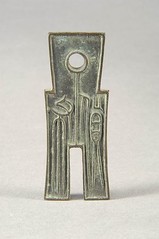
PREV ARTICLE
NEXT ARTICLE
FULL ISSUE
PREV FULL ISSUE
THE ANCIENT COIN MUSEUM OF BEIJING
Here's a numismatic museum western numismatourists might like to check out: the Ancient Coin Museum of Beijing, China.
-Editor
The currency on display runs the gamut from the earliest examples made of seashells to more recent denominations in gold, pottery and animal bones. In Chinese history, not all currencies were made by central government. For instance, ordinary people were allowed to produce coins in private for market use during the governing period of the emperor Liu Che in Han Dynasty, said Wang Peiwu, a director of the museum. Between the Spring and Autumn (770-476 BC) and the Warring States (475-221 BC) Periods, the currencies were changed into the shape of tools like knives, shovels and wheels. Of them, some coins are just about 1 centimeter big. Some were very rare coins that were only made during a particular short period, for instance, one was made by the local warlord Liu Yuzhou, who governed Beijing during the Five Dynasties and Ten States period (907-965). That is considered to be the only one left in existence. Some coins here were not intended for circulation, but for other purposes, like the keju coins that were presented for good luck to those who would attend the imperial examination. The coins with a dragon and phoenix were for celebrating weddings, while some with Bodhisattva pictures were for wearing on the body or hanging indoors for good luck. One of the most interesting displays is of a collection of silver pieces or sui yin. Wang explained that in the old days, people often cut silver coins into smaller pieces to be used for change. Today such an action would be considered destruction of public property. "But then the silver coin's value was determined by its weight," Wang said. "So that wasn't 'destroying,' it was just 'making change.'"
To read the complete article, see:
We're in the money
(life.globaltimes.cn/travel/2010-07/548471.html)
The Numismatic Bibliomania Society is a non-profit organization promoting numismatic literature. See our web site at coinbooks.org. To submit items for publication in The E-Sylum, write to the Editor at this address: whomren@gmail.com To subscribe go to: https://my.binhost.com/lists/listinfo/esylum All Rights Reserved. NBS Home Page Contact the NBS webmaster 
|
